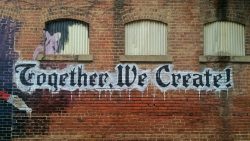Reports from small group work can be interminable if given verbally and linearly. But there are great tools to make reporting back and incorporating the wisdom from small groups manageable. The foundational ToP methods of Focused Conversation and Consensus Workshop Method work well, and there are many more useful methods from other sources.
The Consensus Workshop Method, for example, has small groups share and write their ideas on cards after individual brainstorming, paying attention to maintaining the diversity of ideas within the group. Then these cards are posted on the wall and clustered by the large group. If there are questions of clarification, the group is asked to explain what they meant when they wrote them. Finally the clusters are named and the content is drawn together with a large group conversation.
If you are working with a large group of 100 or so, you can also consolidate the results of several smaller consensus workshops into a larger consensus, using the clustering process with the results of the smaller workshops. Descriptions of this process can be found on page 149 of The Workshop Book, by Brian Stanfield, and page 64 in Getting to the Bottom of ToP, by Wayne and Jo Nelson.
If the group needs to understand a complex document, the Charting Method is useful. Small groups can be assigned a section of the document. They use a Focused Conversation to understand the key points of their section, then post it on a visual overall chart with the other reports. The large group looks at the total picture using another Focused Conversation to discern the implications of the whole document. This process is described in Chapter 11 of Getting to the Bottom of ToP. In the Art and Science of Participation course, you experience a demonstration of the Charting Method and leave with procedures to use it with a group.
A Gallery Walk has reports on flipchart pages (or different parts of a virtual whiteboard) around the room where “tour groups” walk from one to another, reading the reports and writing questions or comments on the flipchart. A Focused Conversation in the large group on what they have gleaned from the flipcharts honours the small group work and begins to bring it together.
In Model Building, the large group does a consensus workshop on either the elements of the needed model, or the values the group needs to hold in a final model. Then small groups draw up models based on the common elements or values, and the whole group reflects on them and merges them to create an overall model. In the Advanced ToP Tools course, you experience a demonstration of Model Building and Merging, and leave with procedures to use it.
Sam Kaner suggests Simultaneous Committees, where small groups of 2 or more each work on an action plan for an assigned portion of the task, then bring it back to the large group to merge it with the other portions.
Many other facilitation tools can be used with small groups, with the results feeding into discussion in a large group.
We explore 72 different meeting tools and techniques for small and large groups including the ones above in our Meetings that Work course.






